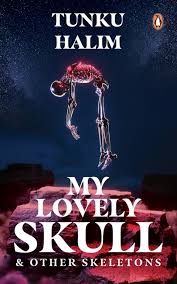
© Penguin Books
Here’s another entry for the run-up to Halloween…
The horror stories in Malaysian writer Tunku Halim’s collection My Lovely Skull and Other Skeletons (2022) don’t hint at what, for much of his life, he’s done as a career.
In fact, Halim qualified as a barrister in England and then practised corporate and conveyancing law in Malaysia and Australia. That’s why his Wikipedia bibliography contains not only such titles as Dark Demon Rising (1997), Blood Haze: 15 Chilling Tales (1999) and Gravedigger’s Kiss (2007), but also Everything the Condominium Developer Should Have Told You But Didn’t (1992) and Condominiums: Purchase Investment & Habitat (1996). Also, he’s published children’s fiction, children’s encyclopedias, books on losing weight and books on playing golf. Though Halim has been described as ‘Asia’s Stephen King’, I don’t believe Maine’s word-slinging ‘Master of Pop Dread’ has ever got around to penning tomes on watching your waistline or improving your handicap on the golf course.
Similar variety is found among the 15 tales in My Lovely Skull. They range in tone from the highbrow and elegiac to the unashamedly hokey. In the latter category is Karaoke Nightmare, in which a woman with a love for performing Mariah Carey but a hopeless singing voice – personally, I find Ms. Carey’s output hideous whether it’s sung in tune or not – finds some weird singing lessons on YouTube. She falls under the spell of the singing teacher, known simply as ‘Air’, who has ‘intense, mysterious, coal-black eyes’ and ‘looks a bit like Jin from BTS except that his hair is greasy black’, and who addresses her directly from her TV screen. Air ensures that her next get-together with her friends in a karaoke box is, literally, murder.
Also amusingly schlocky is The Festival, in which some dog-lovers take umbrage at an event they see advertised as a ‘dog eating festival’ and turn up at it to protest. They discover, to their horror, that they’ve misunderstood the event’s semantics. What’s being eaten, and what’s doing the eating, are not what they think. I read somewhere that Halim is scared of dogs, a fear that no doubt inspired this tale.
More serious are his stories of psychological horror. In the tale that lends the book its name, My Lovely Skull, the narrator describes his descent into madness after finding a human skull on a beach. It isn’t long before he believes the skull – a female one – is speaking to him, crooning sweet but creepy words of seduction at him one minute, exhorting him to commit murder the next. Meanwhile, Cathedraphobia contains another descent into madness, and more murder, as the phobia of the story’s title gets the better of its main character. Cathedraphobia isn’t a fear of cathedrals, as you might expect, but a fear of chairs. Chairs have featured occasionally in macabre fiction – electric chairs, obviously, and haunted rocking chairs that move by themselves, and there’s Edogawa Rampo’s brilliantly morbid The Human Chair (1925) – but this is the first story I’ve come across involving someone being irrationally afraid of them.
I prefer, though, the collection’s stories that seem inspired by Halim’s local folklore. Waiting for You features a woman walking her dog whilst trying to forget the horribleness of her domestic situation – she’s married to a drunken, abusive husband – who stumbles across a grove of banana trees growing by a wall on the edge of some jungle. There, she unwittingly provokes a terrifying demon that resides among the trees: “…wearing a white smock, squatting, back propped against the wall. The face was hidden by long black hair that draped like curtains to the ground and merged with the mocking pools of blackness.” Although this fearsome entity is referred to only as the ‘demon’, I assume from its description, and the fact it’s found living among banana trees, and the fact it’s accompanied by a foul stench, that it’s a pontianak, “a mythical creature in Indonesia, Malaysia and Singapore… often depicted as a long-haired woman dressed in white.”
Also unidentified is the monstrous baby in Dream Baby. It’s found by a couple, ironically a childless couple who’ve tried IVF treatment in their desperate attempts to have offspring, after their car breaks down in the middle of the jungle. This time, I assume the beastly wee creature, the back of whose head is ‘a sickly grey’ and who has ‘several ugly bumps like tumours’ protruding from its spine, is inspired by another being from Malaysian and Indonesia folklore, the toyol. But while the normal toyol scuttles around and commits crimes on behalf of anyone who manages to tame it, talking advantage of its small size to break into other people’s homes, rob them and bring back their riches, the infant creature in Halam’s story just wants to drink blood… and kill.
Incidentally, there’s a pleasing riff on a more recent type of folklore, the urban myth, in The Elevator Game. The hero of this story is a social-media influencer who decides for his latest video to test the claim that by pressing a certain sequence of numbers in a lift – ‘G-3-1-5-1-9-4-G’ – you’ll eventually make the lift-doors open onto the afterlife and its ghostly inhabitants. This game is said to originate in ‘Korea or Japan’ and, appropriately, the story’s uneasy atmosphere resembles that of one of the numerous Japanese horror (‘J-Horror’) movies based on modern legends.
For me, My Lovely Skull’s best two stories come at the end. Moongate is set on the hillwalking trail of the same name on Malaysia’s Penang Island and features a couple who, whilst hiking there, have some disturbing experiences with a recurring, and rapidly aging, figure dressed in yellow. Their increasing panic leads to an accident – and one of them disappearing. The other member of the couple is left trying to figure out what happened. A story that impressively combines the sinister, the disorientating and the tragic, Moongate benefits from being set near the end of the Covid-19 pandemic. The grief depicted here, at the unexpected and bewildering loss of a loved one, echoes how many felt during the pandemic when family members and friends were snatched away by a virus that suddenly seemed to arrive from nowhere.
Equally good is the ultimate story, Water Flows Deepest, where perhaps there is a suggestion of Halim’s legal background and his expertise with condominiums. It’s set in a globally-warmed future where rising sea-levels inundate the world’s coasts, especially at high-tide. The story’s characters are a handful of people still stubbornly living in “a drab grey tower that stood high up against the ashen sky. It was once touted as a luxury seafront condominium but now it was a towering island citadel under constant siege… The guard house, its walls water-stained, stood empty…” Its driveway “was littered by sea debris which scattered up past the small roundabout to the lobby and then down to the basement parking. The parking entrance was dark like an open mouth and completely flooded.”
If this dystopian vision of future condo-living calls to mind, say, the works of J.G. Ballard, the story also contains a strong element of Stephen King. The characters have heard disturbing rumours of a deadly amorphous creature, ‘like a black curtain or an oil slick’, lurking in the steadily-rising, steadily-advancing seawater. This calls to mind King’s short story The Raft, which appeared in his 1985 collection Skeleton Crew and was adapted as the middle instalment in the three-story anthology movie Creepshow 2 (1987). I found the ending of Water Flows Deepest a little over-the-top, but the build-up to it is impressively, and wetly, ominous.
My Lovely Skull and Other Skeletons, then, is nicely varied in tone and content, and if a few tales are plainly not to be taken seriously, they have the saving grace of being good fun. The collection is also visceral. The horrors populating Halim’s short fiction are indiscriminate and though bad people meet gruesome ends, so too do morally neutral and decent ones.
Finally, Halim writes in a brisk, crisp and to-the-point style that looks easy to reproduce and makes the art of short-story writing look easy to do. That he makes them look so is a testament to his skill because both things aren’t easy. (I know this as a short-story writer myself.) Also, five of the 15 stories here are written in the present tense, a stylistic affectation I often find intrusive and annoying, but Halim carries it off so well that I didn’t even notice while I was reading them.



